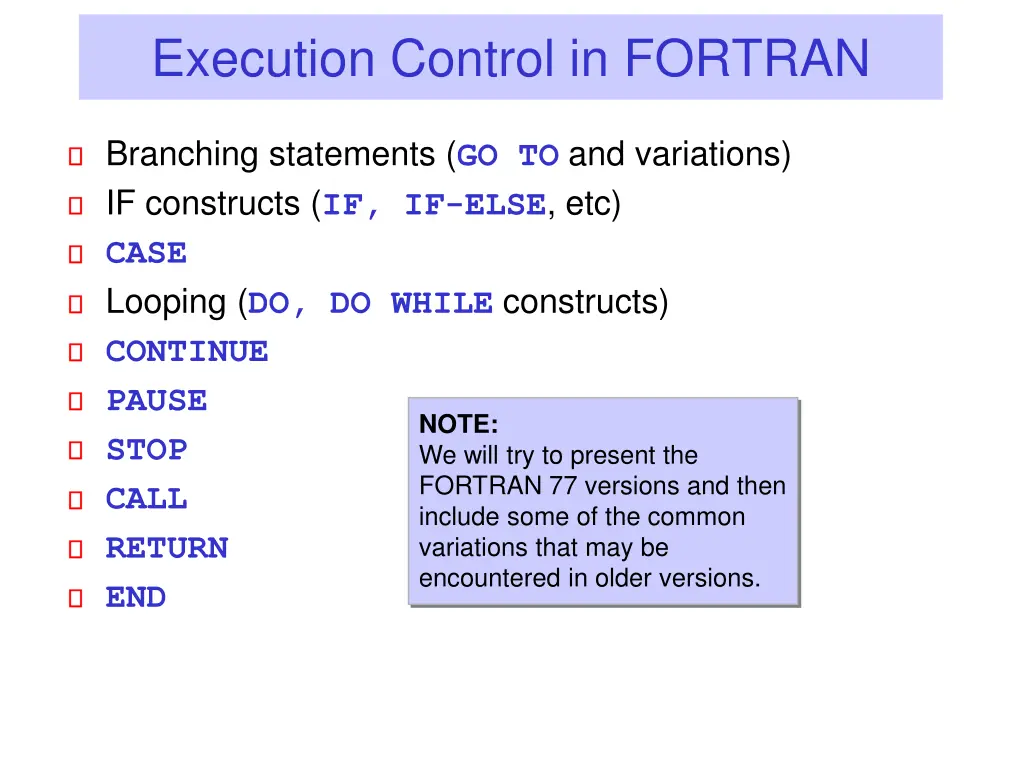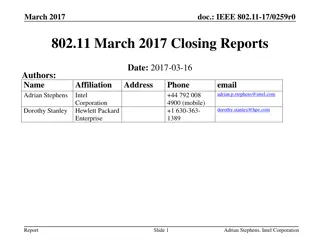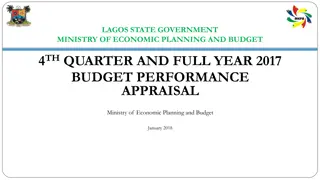
Exploring Fortran 77 Control Structures and Statements
"Dive into the fundamentals of execution control in Fortran 77, covering branching statements, IF constructs, looping, and various control statements such as GO TO, IF-ELSE, and DO constructs with their syntax and examples to enhance your Fortran programming skills."
Download Presentation

Please find below an Image/Link to download the presentation.
The content on the website is provided AS IS for your information and personal use only. It may not be sold, licensed, or shared on other websites without obtaining consent from the author. If you encounter any issues during the download, it is possible that the publisher has removed the file from their server.
You are allowed to download the files provided on this website for personal or commercial use, subject to the condition that they are used lawfully. All files are the property of their respective owners.
The content on the website is provided AS IS for your information and personal use only. It may not be sold, licensed, or shared on other websites without obtaining consent from the author.
E N D
Presentation Transcript
Execution Control in FORTRAN Branching statements (GO TO and variations) IF constructs (IF, IF-ELSE, etc) CASE Looping (DO, DO WHILE constructs) CONTINUE PAUSE STOP CALL RETURN END NOTE: We will try to present the FORTRAN 77 versions and then include some of the common variations that may be encountered in older versions.
Unconditional GO TO This is the only GOTO in FORTRAN 77 Syntax: GO TO label Unconditional transfer to labeled statement 10 -code- GO TO 30 -code that is bypassed- 30 -code that is target of GOTO- -more code- GO TO 10 Flowchart: 30 GOTO 30 Problem: leads to confusing spaghetti code
Other GO TO Statements Computed GO TO Syntax: GO TO (list_of_labels) [,] expression selects from list of labels based on ordinal value of expression Ex: GO TO (10, 20, 30, 50) KEY+1 Assigned GO TO Syntax: ASSIGN label TO intvar GO TO intvar [ [,] (list_of_valid_labels)] Ex: ASSIGN 100 TO L2 - code GO TO L2, (10, 50, 100, 200) NOTE: In syntax, [ ] means items enclosed are optional
IF Statements Basic version #1 Syntax: IF (logical_expression) GO TO label If logical expression is true, execute GO TO, otherwise continue with next statement Ex: IF (X.GE.0) GO TO 340 Flowchart: yes X < 0? 340 no Basic version #1 Syntax: IF (logical_expression) statement If logical expression is true, execute statement and continue, otherwise, skip statement and continue Ex: IF (K.LT.0) K=0 Flowchart yes X < 0? K=0 no
IF THEN ELSE Statement Basic version: Syntax: IF (logical_expression) THEN statement1(s) ELSE statement2(s) ENDIF If logical expression is true, execute statement1(s), otherwise execute statemens2(s), then continue after ENDIF. Ex: IF (KEY.EQ.0) THEN X=X+1 ELSE X=X+2 ENDIF Flowchart: no yes KEY= 0? X=X+1 X=X+2
IF ELSE IF Statement Basic version: Syntax: IF (logical_expr1) THEN statement1(s) ELSE IF (logical_expr2) THEN statement2(s) ELSE statement3(s) ENDIF If logical expr1 is true, execute statement1(s), if logical expr2 is true, execute statement2(s), otherwise execute statemens3(s). Ex: 10 IF (KSTAT.EQ.1) THEN CLASS= FRESHMAN ELSE IF (KSTAT.EQ.2) THEN CLASS= SOPHOMORE ELSE IF (KSTAT.EQ.3) THEN CLASS= JUNIOR ELSE IF (KSTAT.EQ.4) THEN CLASS= SENIOR ELSE CLASS= UNKNOWN ENDIF yes KEY= 1? X=X+1 no yes KEY= 2? X=X+2 no yes KEY= N? X=X+N no X=-1
Notes on IF Statements Avoid using IF with GO TO which leads to complex code Statement blocks in IF THEN and IF ELSE IF statements can contain almost any other executable FORTRAN statements, including other IF s and loop statements. CANNOT transfer control into an IF statement block from outside (e.g., using a GO TO) CAN transfer control out of an IF statement block (e.g., using an IF ( ) GO TO N statement) Use indenting to make code readable.
Old IF Statements Arithmetic IF statement (3-branch) Syntax: IF (num_expr) label1, label2, label3 If num expr is <0 then go to label1, if =0 then label2, and if >0 then go to label3 Ex: IF (THETA) 10, 20, 100 Arithmetic IF statement (2-branch) Syntax: IF (num _ expr) label1, label2 If num expr is <0 then go to label1, if >0 then go to label2 Ex: IF (ALPHA-BETA) 120, 16 Notes: Avoid whenever possible! Leads to very confusing and hard to understand code..






















